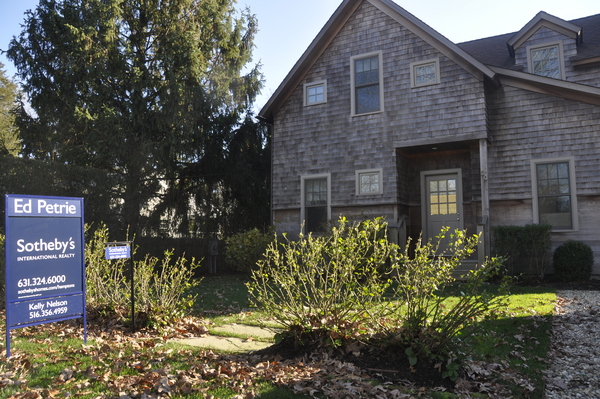
When it comes to real estate signs, East Hampton-based builder Brad Roaman wants to prove that size isn’t everything. And bigger isn’t necessarily better.
His plan of attack was to offer an exclusive on two of his East Hampton Village properties to the real estate agency that agreed to use 4-inch-by-10-inch “For Sale” signs, as opposed to the 7-square-foot signs currently allowed that are more than double the size.
“Real estate signs are large. They’re unattractive,” Mr. Roaman, the owner of BSR Construction Services, said during a telephone interview last month. “They make the neighborhood feel like a Monopoly board as opposed to a community.”
A few weeks ago, Sotheby’s International Realty took the bait offered by Mr. Roaman. The signs, which are white on royal navy blue—the agency’s colors—include only the firm’s name and telephone number, according to John Gicking, brokerage manager and vice president of the company’s East Hampton office. Agents Ed Petrie and Kelly Nelson are managing Mr. Roaman’s properties, he said.
“Ed, Kelly and I are very eager to try something different,” Mr. Gicking said during a recent telephone interview. “We told him we’re game. I’ve, personally, long felt that signs typically used by brokers here are too prevalent, too large and reinvite the perception that every other house is for sale in the Hamptons, which is not the case.”
Before entering the sale market, both of Mr. Roaman’s properties were rentals, the builder said. The first, a renovated, 2,000-square-foot East Hampton cottage, sits on a half acre on Buell Lane Extension. The 3-bedroom, 3½-bath home is listed for nearly $1.5 million.
The second, a newly constructed, 1,800-square-foot house on Maidstone Avenue is on the market for $1.4 million, according to its listing.
And even without the signs up, which were installed last month, 30 prospective house buyers had already taken a look at the properties, Mr. Roaman reported.
“That’s how the industry works!” he exclaimed. “We need to make some change, and I’m using my position as a seller to institute some change. The Maidstone house is two doors down from Mayor Rickenbach’s.”
But the mayor is already a step ahead of Mr. Roaman, whose stand against the system only adds fuel to Mayor Paul F. Rickenbach Jr.’s fire. At an East Hampton Village Board meeting in November, the mayor proposed paring down the size of real estate signs from 7 square feet to 1½ square feet, which is the largest size allowed in Shelter Island Town as of April 2010, Mayor Rickenbach pointed out at the meeting. He reported that Shelter Island Supervisor James Dougherty told him that there had been less resistance to the size limit than expected.
“East Hampton Village is not for sale,” the mayor said at the meeting. “It sends the wrong signal.”
The Village Board hasn’t settled on a particular size and there isn’t an official proposal on the table, according to Village Administrator Larry Cantwell. It will be further discussed at the Village Board’s work session on Thursday, December 1.
“For the sake of convenience, it would be great if the various villages and towns could come up with consistent policies so we don’t have to order different-sized signs for each municipality or hamlet,” Mr. Gicking said.
Currently, East Hampton Town code states that real estate signs must not exceed 6 square feet. The village code, which is 7 square feet, supersedes that of the town. Southampton Town code sets the maximum at 4 square feet. Across the canal, Westhampton Beach Village code has already set a real estate sign restriction. That village allows signs as large as 12-inches-by-18-inches.
“It’s an interesting concept,” Mr. Cantwell said of reducing the sign size during a telephone interview last week. “Sometimes, by going to discreet-sized signs, since people are so used to looking at the standard size, a smaller size could attract more attention.”
However, the percentage of sales that actually comes from signage, according to Mr. Gicking, isn’t incredibly substantial anyway. The majority of the leads that his firm snares are actually thanks to the internet, he said.
“Arguably, the signs are good PR for both firms and the agents, and attract attention to properties that are for sale,” Mr. Gicking noted. “I’m not suggesting that signs are banned outright, but it’s worth investigating and reviewing the standards.”
Ideally, Mr. Roaman—who has owned BSR Construction Services in East Hampton for 20 years—would like to see white-on-black, 4-by-10-inch plaques become the norm, as they have in Palm Beach, Florida, he said.
“Most realtors will tell you under their breath that they’d rather have smaller signs. They don’t want to live on a street with big signs, either,” Mr. Roaman said. “But no one wants to break tradition. We all know that if a house is going to sell, it’s going to sell. It’s not because of the sign.”